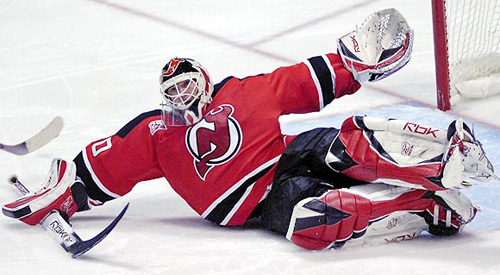
Martin Brodeur and the retirement question
He’s played hockey in three different decades and has a resume highlighted by three Stanley Cups, two Olympic gold medals, five William M. Jennings Trophies, four Vezinas, 10 All-Star selections and one Calder Trophy for good measure. Now, at age 39, the end of Martin Brodeur’s storied career is in sight.
Last season, the New Jersey Devils slogged through one of their worst seasons in recent memory. Their reigning superstar suffered what essentially amounted to a season-ending injury; their newly-acquired superstar started the season like he already suffered a season-ending injury; and the rock of their three championships, Brodeur, had one of the worst seasons of his career, temporarily relinquishing the starting job to journeyman Johan Hedberg.
Brodeur’s .903 save percentage was his lowest since 1994-95 and his goals-against average was the highest since 2005-06. He played in less than 70 games for only the fifth time in his entire career. He used to be a constant to many.
Even after playing stellar hockey in the second half of the season, the Devils missed the playoffs for the first time in 15 years. Now, both Brodeur and the Devils face a harsher reality: their last three trips to the postseason resulted in first-round defeats, despite being heavy favorites in each series. In two of those series Brodeur was bad, posting a sub-.900 save percentage and a goals-against average over 3.00.
Looking at these stats, plus the fact that Brodeur is in the final season of a six-year deal, many people wonder whether his illustrious career is coming to an end. Could this be his final season?
[php snippet=1]
Well, not if the Devils are smart.
Brodeur’s below average numbers from last season are largely the product of a rough start. Over the first three months of the season, Brodeur’s goals-against average was 2.84 and his save percentage was .886. However, from January to the end of the year, Brodeur’s goals-against average was under 2.00 and his save percentage was .919, putting Broduer in the upper half of the league for the split.
It’s no coincidence that Brodeur’s numbers actually jumped during the second half of the season. First, and most obviously, New Jersey began to play better as a whole, ensuring that Brodeur wasn’t shelled as violently as he was prior. Second, and more importantly, Brodeur was fresher than he had been in years as Hedberg started more games during the first half of the season.
Brodeur finished the campaign by playing in less than 60 games for the first time since 1996-97 (excluding 2008-09 when he was out of the lineup for a prolonged period with an injury). Despite being in his late-30s, the Devils have insisted on playing Brodeur like he was in his mid-20s. He’s topped 75 games four times in his 30s alone.
As a comparison, Patrick Roy never played in more than 70 games, and during his 30s, he played in 10 fewer games per year than Brodeur did on average. Dominik Hasek only once broke 70 games in his career – coming when he was 33 – and when he approached age 40 he played less frequently, splitting duties in Ottawa and Detroit.
Some may view Brodeur’s down year as a sign of his imminent departure from the game, but his second-half numbers suggest that he’s still a very good option in net for the Devils, although perhaps no longer the elite goaltender he once was. If the Devils are smart with Brodeur, they will reduce his workload during the regular season, ensuring he’s a sharper, fresher player by the stretch run, and in future seasons.
What complicates matters is that New Jersey is no longer the automatic playoff team it was for many years. If the Devils are in a battle all year long for one of the final few playoff spots, they may ride Brodeur into the ground, playing him as much as they have to to get by.
If that’s the case, it’s unlikely Brodeur’s career will have the storybook ending we hope for, people’s last memories instead being of an aging superstar, passed by the game he used to dominate.
[php snippet=1]

